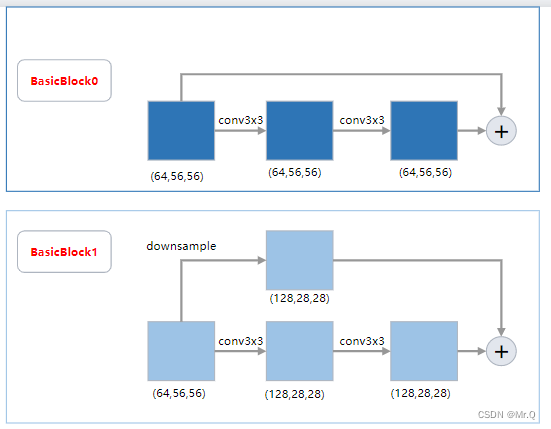libtorch c++ 使用预训练权重(以resnet为例)
| 阿里云国内75折 回扣 微信号:monov8 |
| 阿里云国际,腾讯云国际,低至75折。AWS 93折 免费开户实名账号 代冲值 优惠多多 微信号:monov8 飞机:@monov6 |

任务 识别猫咪。
目录
1. 直接使用
1.1 获取预训练权重
比如直接使用Pytorch版的预训练权重。先把权重保存下来并打印分类类别方便后面对比
import torch
import torchvision.models as models
from PIL import Image
import numpy as np
# input
image = Image.open("E:\\code\\c++\\libtorch_models\\data\\cat.jpg") # 图片发在了build文件夹下
image = image.resize((224, 224), Image.ANTIALIAS)
image = np.asarray(image)
image = image / 255.0
image = torch.Tensor(image).unsqueeze_(dim=0) # (b,h,w,c)
image = image.permute((0, 3, 1, 2)).float() # (b,h,w,c) -> (b,c,h,w)
# model
model = models.resnet18(pretrained=True)
model = model.eval()
resnet = torch.jit.trace(model, torch.rand(1, 3, 224, 224))
# infer
output = resnet(image)
max_index = torch.max(output, 1)[1].item()
print(max_index) # ImageNet1000类的类别序号
resnet.save('resnet.pt')将保存权重resnet.pt并打印分类索引号是283对应的是猫。
1.2 libtorch直接使用pt权重
使用接口torch::jit::load 即可载入权重并获取resnet18模型。
然后再使用std::vector<torch::jit::IValue>传送数据到模型中即可得到类别。
打印结果是283和前面的pytorch版是一样。
#include <iostream>
#include <opencv.hpp>
int main()
{
// load weights and model.
auto resnet18 = torch::jit::load("E:\\code\\c++\\libtorch_models\\weights\\resnet18.pt");
assert(module != nullptr);
resnet18.to(torch::kCUDA);
resnet18.eval();
// pre
cv::Mat image = cv::imread("E:\\code\\c++\\libtorch_models\\data\\cat.jpg");
cv::resize(image, image, cv::Size(224, 224));
torch::Tensor tensor_image = torch::from_blob(image.data, {224, 224,3 }, torch::kByte);
tensor_image = torch::unsqueeze(tensor_image, 0).permute({ 0,3,1,2 }).to(torch::kCUDA).to(torch::kFloat).div(255.0); // (b,h,w,c) -> (b,c,h,w)
std::cout << tensor_image.options() << std::endl;
std::vector<torch::jit::IValue> inputs;
inputs.push_back(tensor_image);
// infer
auto output = resnet18.forward(inputs).toTensor();
auto max_result = output.max(1, true);
auto max_index = std::get<1>(max_result).item<float>();
std::cout << max_index << std::endl;
return 0;
}2. 间接使用
间接使用是指基于libtorch c++ 复现一遍resnet网络再利用前面得到的权重初始化模型。输出结果依然是283.
#include <iostream>
#include "resnet.h" // libtorch实现的resnet
#include <opencv.hpp>
int main()
{
// load weights and model.
ResNet resnet = resnet18(1000); // orig net
torch::load(resnet, "E:\\code\\c++\\libtorch_models\\weights\\resnet18.pt"); // load weights.
assert(resnet != nullptr);
resnet->to(torch::kCUDA);
resnet->eval();
// pre
cv::Mat image = cv::imread("E:\\code\\c++\\libtorch_models\\data\\cat.jpg");
cv::resize(image, image, cv::Size(224, 224));
torch::Tensor tensor_image = torch::from_blob(image.data, { 224, 224,3 }, torch::kByte);
tensor_image = torch::unsqueeze(tensor_image, 0).permute({ 0,3,1,2 }).to(torch::kCUDA).to(torch::kFloat).div(255.0); // (b,h,w,c) -> (b,c,h,w)
std::cout << tensor_image.options() << std::endl;
// infer
auto output = resnet->forward(tensor_image);
auto max_result = output.max(1, true);
auto max_index = std::get<1>(max_result).item<float>();
std::cout << max_index << std::endl;
return 0;
}接下来介绍resnet详细实现过程。
2.1 BasicBlock
先实现resnet最小单元BasicBlock该单元是两次卷积组成的残差块。结构如下。

两种形式如果第一个卷积stride等于2进行下采样则跳层连接也需要下采样维度才能一致再进行对应相加。
// resnet18 and resnet34
class BasicBlockImpl : public torch::nn::Module {
public:
BasicBlockImpl(int64_t in_channels, int64_t out_channels, int64_t stride, torch::nn::Sequential downsample);
torch::Tensor forward(torch::Tensor x);
public:
torch::nn::Sequential downsample{ nullptr };
private:
torch::nn::Conv2d conv1{ nullptr };
torch::nn::BatchNorm2d bn1{ nullptr };
torch::nn::Conv2d conv2{ nullptr };
torch::nn::BatchNorm2d bn2{ nullptr };
};
TORCH_MODULE(BasicBlock);
// other resnet using BottleNeck
class BottleNeckImpl : public torch::nn::Module {
public:
BottleNeckImpl(int64_t in_channels, int64_t out_channels, int64_t stride,
torch::nn::Sequential downsample, int groups, int base_width);
torch::Tensor forward(torch::Tensor x);
public:
torch::nn::Sequential downsample{ nullptr };
private:
torch::nn::Conv2d conv1{ nullptr };
torch::nn::BatchNorm2d bn1{ nullptr };
torch::nn::Conv2d conv2{ nullptr };
torch::nn::BatchNorm2d bn2{ nullptr };
torch::nn::Conv2d conv3{ nullptr };
torch::nn::BatchNorm2d bn3{ nullptr };
};
TORCH_MODULE(BottleNeck);// conv3x3+bn+relu, conv3x3+bn,
// downsample: 用来对原始输入进行下采样.
// stride: 控制是否下采样stride=2则是下采样且downsample将用于对原始输入进行下采样.
BasicBlockImpl::BasicBlockImpl(int64_t in_channels, int64_t out_channels, int64_t stride, torch::nn::Sequential downsample) {
this->downsample = downsample;
conv1 = torch::nn::Conv2d(torch::nn::Conv2dOptions(in_channels, out_channels, 3).stride(stride).padding(1).bias(false));
bn1 = torch::nn::BatchNorm2d(torch::nn::BatchNorm2dOptions(out_channels));
conv2 = torch::nn::Conv2d(torch::nn::Conv2dOptions(out_channels, out_channels, 3).stride(1).padding(1).bias(false));
bn2 = torch::nn::BatchNorm2d(torch::nn::BatchNorm2dOptions(out_channels));
register_module("conv1", conv1);
register_module("bn1", bn1);
register_module("conv2", conv2);
register_module("bn2", bn2);
if (!downsample->is_empty()) {
register_module("downsample", downsample);
}
}
torch::Tensor BasicBlockImpl::forward(torch::Tensor x) {
torch::Tensor identity = x.clone();
x = conv1->forward(x); // scale/2. or keep scale unchange.
x = bn1->forward(x);
x = torch::relu(x);
x = conv2->forward(x);
x = bn2->forward(x);
// 加入x的维度减半则原始输入必须也减半。
if (!downsample->is_empty()) identity = downsample->forward(identity);
x += identity;
x = torch::relu(x);
return x;
}2.2 实现ResNet
这里以resnet18为例。网络结构如下。

简单一句话使用残差块多次卷积最后接一个全链接层进行分类。
注意上图中的layer1到layer4是由BasicBlock0和BasicBlock1两种残差块组成。实现如下。
// out_channels: 每一个block输出的通道数。
// blocks: 每个layer包含的blocks数.
torch::nn::Sequential ResNetImpl::_make_layer(int64_t out_channels, int64_t blocks, int64_t stride) {
// 1, downsampe: stride or channel
torch::nn::Sequential downsample;
if (stride != 1 || this->in_channels != out_channels * expansion) { // 步长等于2或者输入通道不等于输出通道则都是接conv操作改变输入x的维度
downsample = torch::nn::Sequential(
torch::nn::Conv2d(torch::nn::Conv2dOptions(this->in_channels, out_channels * this->expansion, 1).stride(stride).padding(0).groups(1).bias(false)),
torch::nn::BatchNorm2d(out_channels * this->expansion)
);
}
// 2, layers: first is downsample and others are conv with 1 stride.
torch::nn::Sequential layers;
if (this->is_basic) {
layers->push_back(BasicBlock(this->in_channels, out_channels, stride, downsample)); // 控制是否下采样
this->in_channels = out_channels; // 更新输入通道以备下次使用
for (int64_t i = 1; i < blocks; i++) { // 剩余的block都是in_channels == out_channels. and stride = 1.
layers->push_back(BasicBlock(this->in_channels, this->in_channels, 1, torch::nn::Sequential())); // 追加多个conv3x3且不改变维度
}
}
else {
layers->push_back(BottleNeck(this->in_channels, out_channels, stride, downsample, this->groups, this->base_width));
this->in_channels = out_channels * this->expansion; // 更新输入通道以备下次使用
for (int64_t i = 1; i < blocks; i++) { // 剩余的block都是in_channels == out_channels. and stride = 1.
layers->push_back(BottleNeck(this->in_channels, this->in_channels, 1, torch::nn::Sequential(), this->groups, this->base_width));
}
}
return layers;
}resnet实现。
class ResNetImpl : public torch::nn::Module {
public:
ResNetImpl(std::vector<int> layers, int num_classes, std::string model_type,
int groups, int width_per_group);
torch::Tensor forward(torch::Tensor x);
public:
torch::nn::Sequential _make_layer(int64_t in_channels, int64_t blocks, int64_t stride = 1);
private:
int expansion = 1; // 通道扩大倍数resnet50会用到
bool is_basic = true; // 是BasicBlock还是BottleNeck
int in_channels = 64; // 记录输入通道数
int groups = 1, base_width = 64;
torch::nn::Conv2d conv1{ nullptr };
torch::nn::BatchNorm2d bn1{ nullptr };
torch::nn::Sequential layer1{ nullptr };
torch::nn::Sequential layer2{ nullptr };
torch::nn::Sequential layer3{ nullptr };
torch::nn::Sequential layer4{ nullptr };
torch::nn::Linear fc{ nullptr };
};
TORCH_MODULE(ResNet);// layers: resnet18: { 2, 2, 2, 2 }, resnet34: { 3, 4, 6, 3 }, resnet50: { 3, 4, 6, 3 };
ResNetImpl::ResNetImpl(std::vector<int> layers, int num_classes = 1000, std::string model_type = "resnet18", int groups = 1, int width_per_group = 64) {
if (model_type != "resnet18" && model_type != "resnet34") // 即不使用BasicBlock使用BottleNeck
{
this->expansion = 4;
is_basic = false;
}
this->groups = groups; // 1
this->base_width = base_width; // 64
this->conv1 = torch::nn::Conv2d(torch::nn::Conv2dOptions(3, 64, 7).stride(2).padding(3).groups(1).bias(false)); // scale/2
this->bn1 = torch::nn::BatchNorm2d(torch::nn::BatchNorm2dOptions(64));
this->layer1 = torch::nn::Sequential(_make_layer(64, layers[0])); // stride=1, scale and channels unchange
this->layer2 = torch::nn::Sequential(_make_layer(128, layers[1], 2)); // stride=2, scale/2. channels double
this->layer3 = torch::nn::Sequential(_make_layer(256, layers[2], 2)); // stride=2, scale/2. channels double
this->layer4 = torch::nn::Sequential(_make_layer(512, layers[3], 2)); // stride=2, scale/2. channels double
this->fc = torch::nn::Linear(512 * this->expansion, num_classes);
register_module("conv1", conv1);
register_module("bn1", bn1);
register_module("layer1", layer1);
register_module("layer2", layer2);
register_module("layer3", layer3);
register_module("layer4", layer4);
register_module("fc", fc);
}
torch::Tensor ResNetImpl::forward(torch::Tensor x) {
// 1先是两次下采样. (b,3,224,224) -> (b,64,56,56)
x = conv1->forward(x); // (b,3,224,224)->(b,64,112,112)
x = bn1->forward(x);
x = torch::relu(x); // feature 1
x = torch::max_pool2d(x, 3, 2, 1); // k=3,s=2,p=1. (b,64,112,112)->(b,64,56,56)
x = layer1->forward(x); // feature 2. (b,64,56,56)
x = layer2->forward(x); // feature 3. (b,128,28,28)
x = layer3->forward(x); // feature 4. (b,256,14,14)
x = layer4->forward(x); // feature 5. (b,512,7,7)
x = torch::adaptive_avg_pool2d(x, {1, 1}); // (b,512,1,1)
//x = torch::avg_pool2d(x, 7, 1); // (b,512,1,1)
x = x.view({ x.sizes()[0], -1 }); // (b,512)
x = fc->forward(x); // (b,1000)
return torch::log_softmax(x, 1); // score (负无穷,0]
}创建resnet18和resnet34。其中layers中的数字代表当前layer中包含的BasicBlock个数。
// 创建不同resnet分类网络的函数
ResNet resnet18(int64_t num_classes) {
std::vector<int> layers = { 2, 2, 2, 2 };
ResNet model(layers, num_classes, "resnet18");
return model;
}
ResNet resnet34(int64_t num_classes) {
std::vector<int> layers = { 3, 4, 6, 3 };
ResNet model(layers, num_classes, "resnet34");
return model;
}2.3 BottleNeck
resnet系列框架是一样的不同点是组件有差异。
resnet18和resnet34都是用BasicBlock组件而resnet50及以上则使用BottleNeck结构。如下所示。



BottleNeck有三种形式
1BottleNeck0: stride=1, only 4*channels
2BottleNeck1: stride=1, only 4*channels
3BottleNeck2: stride=2, 4*channels and scales/2
// other resnet using BottleNeck
class BottleNeckImpl : public torch::nn::Module {
public:
BottleNeckImpl(int64_t in_channels, int64_t out_channels, int64_t stride,
torch::nn::Sequential downsample, int groups, int base_width);
torch::Tensor forward(torch::Tensor x);
public:
torch::nn::Sequential downsample{ nullptr };
private:
torch::nn::Conv2d conv1{ nullptr };
torch::nn::BatchNorm2d bn1{ nullptr };
torch::nn::Conv2d conv2{ nullptr };
torch::nn::BatchNorm2d bn2{ nullptr };
torch::nn::Conv2d conv3{ nullptr };
torch::nn::BatchNorm2d bn3{ nullptr };
};
TORCH_MODULE(BottleNeck);// stride: 控制是否下采样stride=2则是下采样且downsample将用于对原始输入进行下采样.
// conv1x1+bn+relu, conv3x3+bn+relu, conv1x1+bn+relu
BottleNeckImpl::BottleNeckImpl(int64_t in_channels, int64_t out_channels, int64_t stride,
torch::nn::Sequential downsample, int groups, int base_width) {
this->downsample = downsample;
// 64 * (64 / 64) / 1 = 64, 128 * (64 / 64) / 1 = 128, 128 * (64 / 64) / 2 = 64.
int width = int(out_channels * (base_width / 64.)) * groups; // 64 * (64/64) / 1. 当前的输出通道数
// 1x1 conv
conv1 = torch::nn::Conv2d(torch::nn::Conv2dOptions(in_channels, width, 1).stride(1).padding(0).groups(1).bias(false));
bn1 = torch::nn::BatchNorm2d(torch::nn::BatchNorm2dOptions(width));
// 3x3 conv
conv2 = torch::nn::Conv2d(torch::nn::Conv2dOptions(width, width, 3).stride(stride).padding(1).groups(groups).bias(false));
bn2 = torch::nn::BatchNorm2d(torch::nn::BatchNorm2dOptions(width));
// 1x1 conv
conv3 = torch::nn::Conv2d(torch::nn::Conv2dOptions(width, out_channels * 4, 1).stride(1).padding(0).groups(1).bias(false));
bn3 = torch::nn::BatchNorm2d(torch::nn::BatchNorm2dOptions(out_channels * 4));
register_module("conv1", conv1);
register_module("bn1", bn1);
register_module("conv2", conv2);
register_module("bn2", bn2);
register_module("conv3", conv3);
register_module("bn3", bn3);
if (!downsample->is_empty()) {
register_module("downsample", downsample);
}
}
torch::Tensor BottleNeckImpl::forward(torch::Tensor x) {
torch::Tensor identity = x.clone();
// conv1x1+bn+relu
x = conv1->forward(x);
x = bn1->forward(x);
x = torch::relu(x);
// conv3x3+bn+relu
x = conv2->forward(x); // if stride==2, scale/2
x = bn2->forward(x);
x = torch::relu(x);
// conv1x1+bn+relu
x = conv3->forward(x); // double channels
x = bn3->forward(x);
if (!downsample->is_empty()) identity = downsample->forward(identity);
x += identity;
x = torch::relu(x);
return x;
}
